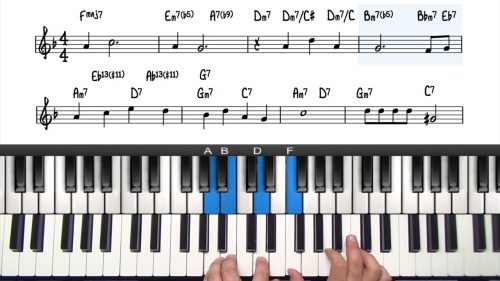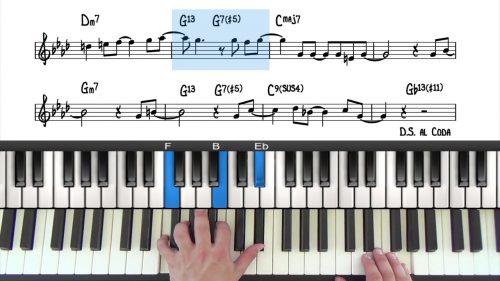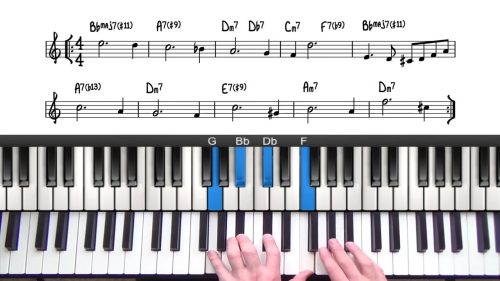Blues Scale Tutorial & Blues Scale Improv
At this point in our study of the blues, now it’s time to introduce the blues scale.
For many students, when starting out with blues improvisation, it’s very easy to get locked inside the notes of the blues scale and never deviate away from 6 tones.
The blues scale can sound amazing when used effectively, but the problem is that beginner jazz students will tend to just play up and down the scale for the whole solo.
This is not particularly interesting and the overall direction and story behind the solo sounds very predictable.
So how do we get around this?
Well, first of all, you now have the foundations in place. These foundations are the effective use of chord tones, flowing approach patterns to smoothly connect your chord tones, and finally the ability to add passing tones and employ chromatic scale passages.
And so now, the blues scale is just another dimension that you can add to your solo, instead of it being the whole solo. As we have seen in previous lessons, you can create a professional sounding solo with just chord tones & carefully chosen approach patterns.
But the blues adds that sprinkle of magic. Everybody loves blues licks and riffs and there is something magical about that group of notes…. It’s just a matter of using and employing them properly.
The Major Blues Scale & The Minor Blues Scale
We know that every major scale has a relative minor scale. So for if we take the C Major scale, and then play the same notes starting a minor 3rd below the root , we then have the A natural minor scale.
Well it’s a very similar concept with blues scales.
First of all we have the minor blues scale built from which contain the root, b3, 4, b5, 5 and b7.
Well if we build a blues scale from a minor 3rd below the root of the F blues scale, that would be the D minor blues scale, and if we play those notes from F to F we have the basic major blues scale.
Another way of looking at the major blues is the major pentatonic with a b3.
So now let’s talk about usage of these 2 scales. In the next lesson we will explore blues licks but for now we’ll keep it simple and just talk about how and when to use these 2 scales.
The minor blues has a funkier sound, whereas the major blues scale has a more soulful and happy sound — this is because it contains the major 3^rd^ and 6th which gives it a major quality.
The Extended Blues Scale
The extended blues scale is the major and minor blues scale combined. The extended blues scale gives you some interesting shapes to play that produce both a funky and gospel infused sound.
We’ll look at this more in the next lesson in this series where we explore some of the intricacies of blues licks.
Lesson Downloads
-
The Major Blues Scale File Type: pdf
-
12 Bar Blues Lesson Supplement File Type: pdf
-
“Straight No Chaser” – Jazz Blues Form File Type: pdf
Practice Tips
-
Build a blues scale from a minor 3rd below the root of the F blues scale, that would be the D minor blues scale, and if we play those notes from F to F we have the basic F major blues scale.
-
Another way of looking at the major blues is the major pentatonic with a b3.
- The F Major pentatonic scale is F-G-A-D-E and the b3 would be Ab to get the F Major blues scale. This is perhaps the easiest method... considering you know you major pentatonic scales.








I Just discovered that in a sentimental mood starts with a pentatonic in f.Its cool when you make this little discoveries.☺
Yes that’s right.
F Major Pentatonic is also D Minor Pentatonic …. that is the relative major/minor relationship. They contain the exact same notes, but starting on different notes.
If you play D Minor Blues from F to F, it gives you the D Major Blues Scale… check out this lesson: pianogroove.com/blues-piano-lessons/the-major-blues-scale/
It’s interesting how the exact same notes, can have a different quality when you start/end on a different note.
That also means that any lines/licks/riffs/patterns that you play with D Minor Blues, will also sounds great over an F Major chord (the relative major to D minor) – that’s an important relationship to understand.
Cheers!
Hayden
Hayden,
Here comes a very very basic one. I am summering my understandings as under;
1) Minor blues = root, b3, 4, b5, 5 and b7
2) Major blues = root, 1, 2, b3, 3, 5 and 6
3) We can build a minor blues scale from a “minor 3rd below” the root of a major blues scale. This is the same way we have the major-minor conversion for heptatonic scales.
Can you pls validate the three statements?
regards,
Shantanu
Hi Shantanu,
Good questions!
Yes these 2 statements are correct:
1) Minor blues = root, b3, 4, b5, 5 and b7
2) Major blues = root, 1, 2, b3, 3, 5 and 6
And for statement (3) let me try and explain this further for you:
Every major blues scale has a ‘relative’ minor blues scale which contains the exact same notes. Yes exactly as you say, this is the same major/minor conversion for heptatonic scales/
If we take the F Major Blues Scale, the notes are F(root) G(2) Ab(b3) A(3) C(5) D(6)
now it we build a minor blues scale from a minor 3rd below which would be D Minor Blues Scale, we have the exact same notes D(root) F(b3) G(4) Ab(b5) A(5) C(b7)
By remembering this relationship, it means that any minor blues line/lick/pattern that you would play over D Minor, can also be played over F Major.
And when we play these notes over an F Major chord in our left hand, it has a ‘happier’, more ‘cheerful’ sound.
When the same notes over D Minor chord in our left hand, it has a ‘darker’ ‘bluesier’ sound.
By understanding the relative relationship, it means that we can get ‘twice as much mileage’ out of our blues licks/lines/patterns – because it’s the exact same notes that can be used over both F Major harmony, and D Minor harmony.
And of course this applies to all keys.
For example:
C Minor Blues can be played over a C Minor Chord, and the same notes can be played over an Eb Major Chord to get a ‘happier’ sounding blues scale.
A Minor Blues can be played over an A Minor Chord, and the same notes can be played over C Major chord to get C Major Blues scale.
etc…
I hope this helps Shantanu.
If I can be of further assistance let me know :-)
Hayden
Dear Hayden,
In the “Major Blues” section, I hope you are referring to “F minor Blues scale” when you mention “F Blues scale”. Pls clarify.
regards,
Hey Shantanu,
Sorry for the late reply here!… I missed the notification.
Yes if I said “Blues Scale” I would be referring to the Minor Blues Scale.
Cheers,
Hayden
Beginner question, but any tips for blues scale fingering? Or practice exercises to help facilitate some
of these basic improvs?
Hi Mark,
Great questions here.
The fingering depends on which blues scale. For F Blues Scale, my fingering would be thumb, index, third, thumb, index, third. If I want to stop the scale, I will play: thumb, index, third, thumb, index, third, fourth.
Also understand that sometimes we might change the fingering to play specific licks and grace notes, and so the fingering is not ‘set in stone’ but the above is a good fingering to follow.
There is also the major blues scale which contains the major 3rd of the scale, and also the 2nd and 6th degrees, we have a lesson on that here: pianogroove.com/blues-piano-lessons/the-major-blues-scale/ – once we add these notes into the scale, we have many more notes to play around with.
Finally, the most important thing Mark is to be listening to recordings and picking up the blues licks and melodic ideas by ear. This is called transcription. You can see more in the following 2 videos:
pianogroove.com/community/t/the-importance-of-listening-transcribing/2737
pianogroove.com/blues-piano-lessons/tips-insights-from-jon/
If you are new to transcription, it is likely that you will need to work on your listening skills first, and so check out these transcription exercises in the forum: pianogroove.com/community/c/improvisation-exercises/30 – In particular check out the beginner and intermediate ear training exercises. Just spend 10 or 15 minutes a day to start and within a few months you will see huge improvement in your ability to pick up licks, lines, and improvised melodies directly from recordings.
I hope that helps Mark and see you in the seminar next week.
Cheers,
Hayden
Great response, Hayden. Time to get to work!
Hey great lesson as always! Is there any trick to find what blues scale would work best for a chord or set of chords aside from the one mentioned regarding minor 2-5-1’s? Thanks In advance.
hello. Your graphic above did not include the b5 (B natural). Needs to be corrected. :)
on the extended blues scale graphic
My question is: if the major blues formula is 1, 2, flat 3, major 3, 5, & 6, wouldn’t the 5 & 6 be C & D in the key of F, Not D & E? Just wanting to understand the formula correctly.
Thanks for your wonderful system!
Hi Karen,
Good question and yes you are exactly right.
The major blues scale is R-2-b3-3-5-6 – you can also look at this as the major pentatonic scale with the addition of the b3.
You might like to check out this lesson where we explore the major blues scale in F Major: pianogroove.com/blues-piano-lessons/the-major-blues-scale/
and we also cover the blues scale in our cocktail piano improvisation course here: pianogroove.com/jazz-piano-lessons/blues-scale-licks-embellishment/
Let me know if I can help further.
Cheers,
Hayden
Hi Hayden. You mention in a few of these lesson a transcription of the Bill Evans solo on Blues inF and some related items which appear to be from a workshop in the forums. I have searched to find these without any luck. Could you point me in the right direction if they still are in the archives. Thanks, Rick
Hi Rick,
Yes after some searching I found that post here: community.pianogroove.com/t/transcription-exercises/147/9
I will also add it into the lesson descriptions in this course as I’m sure other students have been searching for it too!
Thanks for letting me know about this.
Cheers,
Hayden